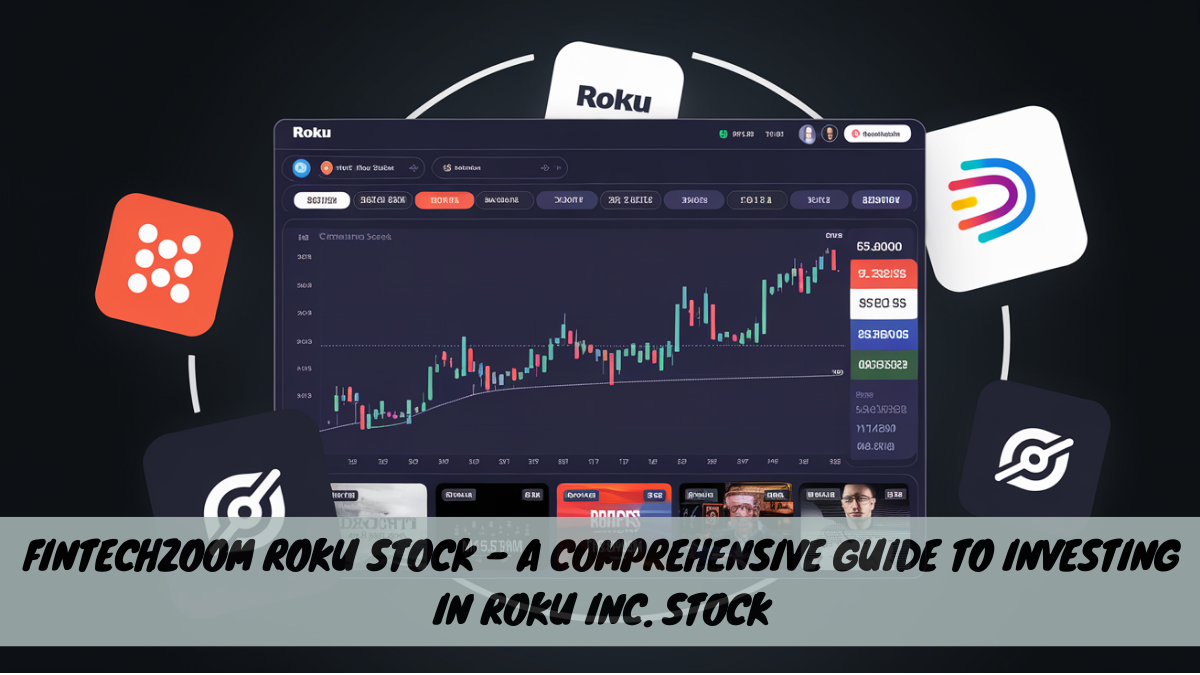Fintechzoom Roku Stock – A Comprehensive Guide to Investing in Roku Inc. Stock
In today’s fast-evolving tech landscape, Roku Inc. has emerged as a major player in the streaming industry, providing a platform that allows users to stream content directly to their televisions. With the rise of streaming services, Roku’s stock has garnered significant attention from investors seeking to capitalize on its growth. As a leading platform for analyzing stocks, Fintechzoom offers insights into Roku stock performance, investment opportunities, and market trends.
“Fintechzoom Roku Stock offers insightful analysis into Roku Inc.’s stock performance, investment strategies, and future potential, helping investors make informed decisions in the fast-growing streaming industry.”
This article provides a comprehensive guide on Fintechzoom Roku Stock, covering everything from Roku’s market performance to investment strategies, and frequently asked questions.
1. Introduction to Roku Inc.
Roku Inc. was founded in 2002, and it has since become one of the leading players in the streaming industry. Roku’s primary business revolves around its streaming platform, which allows users to access thousands of TV channels and streaming services. Roku also manufactures streaming devices, such as Roku TV and Roku streaming sticks, which have made it a household name in the United States.
The company’s innovative business model focuses not only on hardware but also on advertising revenue and partnerships with streaming services. This multifaceted approach has attracted significant attention from investors, making Roku stock a popular choice for those looking to invest in the tech sector.
2. The Rise of Roku in the Streaming Market
Over the past decade, the streaming industry has witnessed exponential growth, with more people cutting the cord on traditional cable and moving towards internet-based streaming services like Netflix, Hulu, and Disney+. Roku’s platform is designed to cater to this growing demand, offering users an easy way to access their favorite content without the need for cable subscriptions.
Roku has become a central player in the streaming ecosystem, as it aggregates content from various platforms, allowing users to easily navigate between streaming services. This convenience has played a significant role in Roku’s rise to prominence.
Additionally, Roku has successfully monetized its platform through advertising, offering targeted ads to users on its free channels. This has allowed the company to diversify its revenue streams, making it an attractive investment option.
3. Understanding Fintechzoom’s Analysis of Roku Stock
Fintechzoom is a widely respected platform that provides in-depth analysis and news about financial markets, including individual stocks like Roku. The platform uses a combination of data analytics, expert opinions, and market trends to give investors a clear picture of a stock’s performance.
When it comes to Roku stock, Fintechzoom offers a thorough analysis of its historical performance, future projections, and how it compares to other stocks in the streaming and tech industries. Investors can use Fintechzoom’s insights to make informed decisions about when to buy, sell, or hold Roku stock.
4. Market Performance and Trends of Roku Stock
Roku’s stock has seen significant growth over the past few years, driven by the increasing demand for streaming services and the company’s ability to generate revenue through advertising. However, like any stock, Roku’s price has also experienced fluctuations due to market conditions, competition, and overall economic factors.
Key Trends:
- Growth in Streaming Services: As more consumers turn to streaming services, Roku’s user base continues to grow, driving up revenue and stock value.
- Advertising Revenue: Roku’s ability to monetize its platform through targeted advertising has boosted its financial performance.
- Partnerships and Acquisitions: Roku’s strategic partnerships with major content providers and acquisitions have strengthened its position in the market.
5. Roku Stock: Historical Data and Price Trends
Looking at historical data, Roku’s stock has experienced periods of rapid growth, especially during times when streaming services have gained popularity, such as the COVID-19 pandemic. Investors who bought Roku stock in its early days have seen substantial returns on their investment.
However, it’s important to note that Roku stock is also volatile, with price swings reflecting changes in the tech industry, competition from companies like Amazon and Apple, and market sentiment.
6. Investment Strategies for Roku Stock
Investors looking to capitalize on Roku’s growth need to adopt smart investment strategies. Some popular strategies include:
- Long-term Investment: For those who believe in the continued growth of streaming services, holding Roku stock for the long term can yield substantial returns.
- Dollar-Cost Averaging: This strategy involves investing a fixed amount in Roku stock at regular intervals, reducing the impact of market volatility.
- Diversification: Investors can balance the risk of holding Roku stock by diversifying their portfolios with other tech and streaming-related stocks.
7. Why Roku Stock is Popular Among Investors
Roku’s stock has gained popularity for several reasons:
- Strong Position in the Streaming Market: Roku is one of the most well-known names in streaming, giving investors confidence in its future.
- Revenue Growth: The company’s ability to generate revenue through both hardware sales and advertising has made it an attractive option for investors.
- Innovation and Expansion: Roku continues to innovate its platform and expand into new markets, providing opportunities for future growth.
8. Risks and Rewards of Investing in Roku Stock
As with any investment, there are risks associated with investing in Roku stock. These include:
- Competition: Roku faces strong competition from other tech giants like Amazon, Apple, and Google, which could impact its market share.
- Market Volatility: Roku stock is known for its volatility, which means that investors could experience significant price fluctuations.
- Economic Downturns: In times of economic uncertainty, consumer spending on streaming services and devices may decrease, affecting Roku’s revenue.
However, the rewards of investing in Roku stock can be substantial, especially for those who believe in the long-term growth of the streaming industry.
9. How Fintechzoom Predicts Roku Stock’s Future
Fintechzoom uses advanced analytical tools to forecast the future performance of stocks, including Roku. According to Fintechzoom, Roku’s future looks promising due to its:
- Continued Growth in Streaming: With more people cutting the cord, the demand for Roku’s platform is expected to grow.
- Expansion into International Markets: Roku has been expanding its presence globally, which could lead to increased revenue.
- Innovations in Advertising: Roku’s ability to offer targeted advertising will likely continue to drive its revenue growth.
10. FAQs About Fintechzoom Roku Stock
1. What is Roku stock, and why is it popular?
Roku stock represents shares in Roku Inc., a leading streaming platform. It’s popular due to Roku’s growth in the streaming industry and its diverse revenue streams.
2. How does Fintechzoom analyze Roku stock?
Fintechzoom uses data analytics, market trends, and expert opinions to provide a comprehensive analysis of Roku stock’s performance and future potential.
3. Is Roku stock a good long-term investment?
Roku stock can be a good long-term investment for those who believe in the continued growth of the streaming industry and Roku’s ability to innovate.
4. What are the risks of investing in Roku stock?
Risks include competition from other tech giants, market volatility, and the impact of economic downturns on consumer spending.
5. How does Roku generate revenue?
Roku generates revenue through hardware sales, targeted advertising, and partnerships with content providers.







